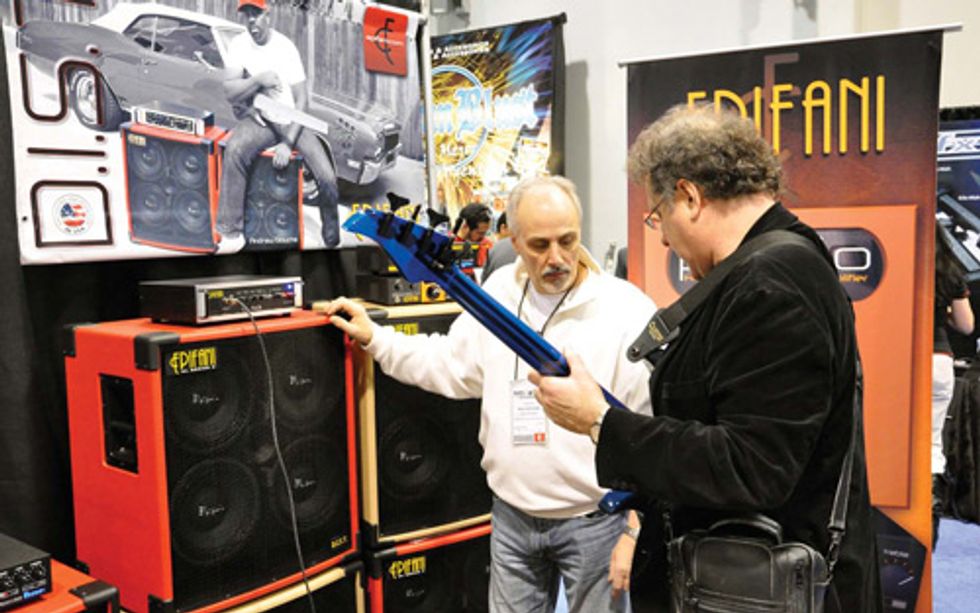
Epifani Amplification founder Nick Epifani with jazz/fusion bassist
Brian Bromberg at Winter NAMM 2011 last January.
Call it fate or call it destiny, some things were just meant to happen. When Nick Epifani started his journey from Torino, Italy, to New York City, he had no idea that one day his ideas and innovations would shape the way bass gear is manufactured, designed, and heard. And this from a drummer-turned-guitarist who started a company in his garage and played mad scientist with bass-cabinet designs. As a chronic tinkerer, Epifani had been modding guitar amps and cabinets from day one. Never quite satisfied with tones, he set out to either make a better cabinet or alter the amp to his liking. The result was a cab that not only shook foundations (literally and figuratively), but broke new ground for the bass world. His bass cabinets and amps have steadily risen in popularity over the years, and they can now be found onstage with many of the most capable bassists on the planet.
But while Epifani may not have foreseen how his design would change the bass universe, his success was no accident. His first cabs were labors of love produced one at a time at home. For 10 years, he worked there by day, and every night he’d set out to jazz clubs to introduce his wares to players around the city. After a fateful meeting with representatives from Fodera Guitars, his business really caught afire as players such as Matt Garrison (Pat Metheny, John McLaughlin, Herbie Hancock), Lincoln Goines (Mike Stern, Carly Simon, Robert Palmer), and Darryl Jones (Rolling Stones, Eric Clapton, Madonna) began using his cabinets and amps onstage and in the studio.
We recently spoke with Epifani about his innovations—from the first cabinet he built in Italy for his brother to his latest digital amps and cabinets—his perseverance, and his steadfast determination to blaze a path all his own.
How did you first get involved with music?
I was 13 years old and started as a drummer in Italy, then formed a band with my cousin and my brother. There was always a guitar in the house, so I knew a few things on guitar, as well. We grew up listening to Hendrix and Grand Funk Railroad, so that was the inspiration for the music. LPs were hard to come by, so when we got our hands on one it was like a sacred bible to us. When I was 18, the band booked a two-month gig in Holland, and our guitar player backed out at the last minute so I moved to guitar.
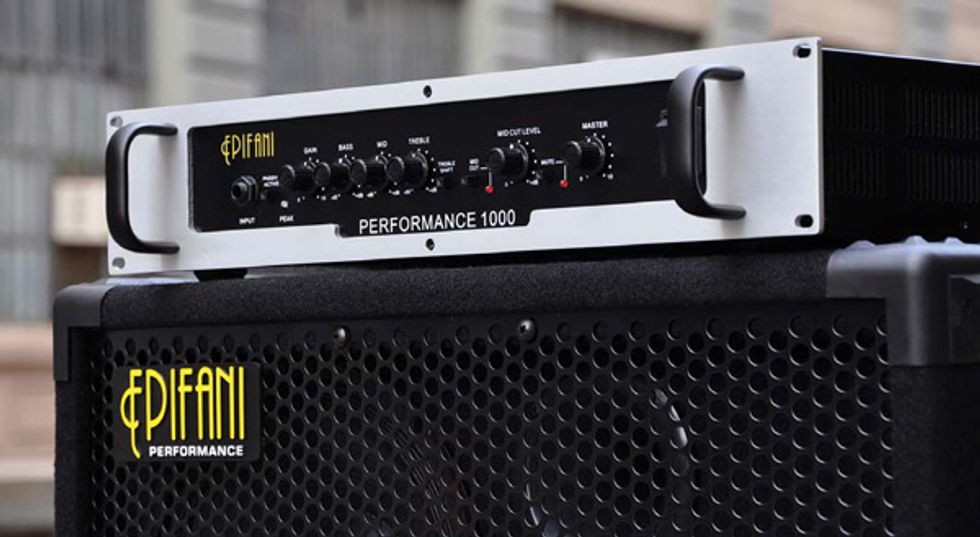
The PS series of heads is based on the now-legendary UL series but offers a warmer sound in a more compact package. Maintaining a solid 500-watt output (1000 watts bridged), the PS 1000 is packed with features.
What brought you to New York?
After bouncing around various gigs, I started a business delivering vegetables in Italy. The work was from 6 a.m. until 1 p.m., so that freed up my afternoons, where I worked in a very big music store. One day, a customer came in and asked about finding guitar players to work on a cruise ship. This was in the late ’70s, and the idea intrigued me. One of the selling points was that the ship would sail from New York City to the Bahamas, passing through the Bermuda Triangle. So the whole situation sounded like one big adventure. I played disco up and down the East Coast, and when my time was up, I made New York my home. I continued playing in wedding bands in NYC for a few years while working a day job.
When did you start building gear?
The first thing I ever built was a 2x12 bass cabinet for my brother when I was 17 or 18. I scrounged up whatever I could find for materials, but I had no idea what I was doing.
Do you still have it?
I wish! I was still playing my gig, so I would change out components—this speaker or that component—and one day I thought “Why can’t we make something that sounds good right off the bat? Why do we have to customize things?” So I started making guitar amps and cabs for myself, finding the best materials I could. Pretty soon, people started asking about my gear. Fearing the lack of name-brand status, I would tell them a friend made them for me. I started building in my garage. I did all the cutting, gluing, assembling, etc., and then I would sell them with no name on them.
When did the bass cabinets come into play?
That was a whole new thing. I got laid off for eight months from my day job. I started reading about bass cabinets. On the surface, guitar cabinets are relatively simple—open back, closed back, number of speakers ... there’s not much to them. There are factors that affect the sound, such as wood and grilles, but with a bass cabinet so much more goes into it—so many little nuances such as the paper, the cone, even the pulp of the paper used in the speaker make different sounds. Different speaker suspensions create different sounds, as well, so I spent a lot of time working on that.
How were your initial bass cabs different from others on the market at the time?
You have calculations for tuning the bass cabs, and the engineers know this and sort of leave it there. I took it steps further with bracing and some other things I don’t want to share, but let’s say that I found flaws in the designs and set out to change them. I realized soon after that I could make something that sounded good without following the procedures from published books of that time.
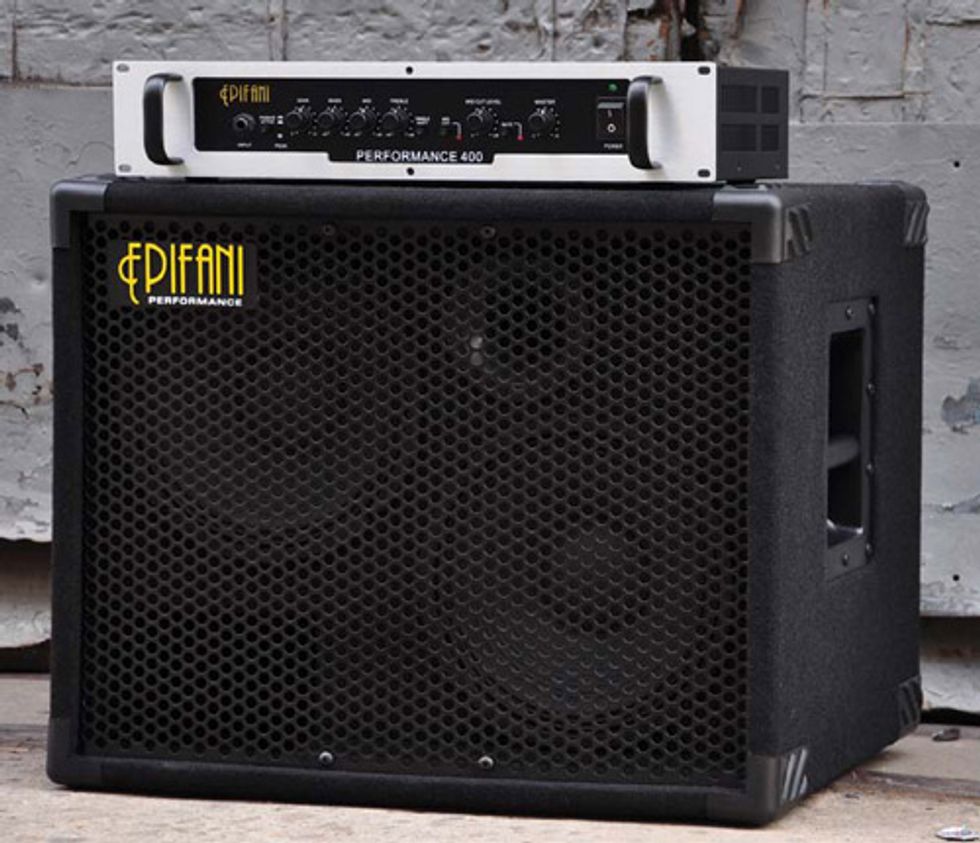
A PS 400 head and a PS 210 cab stand guard outside the Epifani production facilities in Brooklyn.
How did you get your products into players’ hands?
I showed my new bass cabs to some friends, and they were like “Well, nice . . . . ” If you tell someone your car is better than a Mercedes, they will be interested—but ultimately they will buy the Mercedes because that’s what they’re familiar with. So it was tough. I found out that the Fodera bass shop was nearby, and I literally just cold-called them one day and asked if I could bring some cabinets by. We set up the appointment, and as they played their basses through my cabs, they started looking at each other. I thought they hated it, but the looks were actually those of amazement. I had built my cabinets using the best components I could find at the time, so bringing my A game must have worked. Soon after, Fodera introduced me to some of their artists, which led to the first Epifani production bass cabs.
So when did you move out of the garage?
In 1994, I moved into a one-room shop that was in the same space as a furniture factory. I did everything in that little room—from the coverings to assembly. The good thing about the space was that I could use all of the woodcutting tools from the furniture business, so that helped me out tremendously. As I started making cabinets, I opened a dialogue with Eminence to push the speaker manufacturer into some new designs. One change I wanted to make was in the suspension. Up until that point, speakers used an accordion- type suspension, which was problematic. This led to creasing in the speakers from the voice coil pushing forward and the suspension stopping the speaker, but the center would still be moving outward. We developed the M-roll suspension to combat this, and it has now become the industry standard.
Who were some of the artists that shaped your early designs?
I made a 2x12 cabinet for Matt Garrison. I remembered using a Music Man 2x12 cabinet back in the ’70s, but no one was making that configuration anymore. Because I liked the sound and saw the potential in a 2x12, I went with that design. With two 12" speakers, naturally you have more area than with an 18", and that means you can move more air. But, more importantly, it was tuned at a frequency that was better suited for the time. Sadly, the tuning of bass cabs remained unchanged for a number of years, so I adjusted the tuning frequency to get out of that 70-80 Hz range that was standard back then.
One night, I took a cabinet down to the Blue Note, where Lincoln Goines was playing. I dropped off the gear, parked the car, and walked back to the club. In the time that took, Lincoln had already played through it, and he said “I want it.” Lincoln said he knew in the first two notes. He was my first client. The speakers were very fast, very accurate—perfect for that Jaco sort of playing. I think that was one of the best designs, acoustically and technically, but I couldn’t keep it because of the dimensions. It wasn’t made for a line of speakers. When you’re asked to make a line of cabinets, you sort of become restricted in what you can do—because stacking and keeping things uniform aren’t the best formulas for all cabinets.
Can you talk about your relationship with the great Anthony Jackson?
Anthony Jackson was a monster player that everybody respected. In the beginning, I thought he was full of . . . well, you know—because he is literally a genius, and I thought “Nobody is this smart.” I used to mess with him—not in a bad way, but to see if he was full of shit or not: While he was playing, I would turn a knob, like, an eighth of an inch, and he would turn around and say “You touched 450 Hz! I told you I don’t like that!” I had never met someone like that before. He would always be pushing the envelope of knowledge—not just on the surface, but literally seeking knowledge worldwide, requesting special components like imported speakers and silver speaker wire. His cabinets weighed a ton because he wanted 1" wood instead of 3/4". Things like that kept me pushing forward and experimenting.
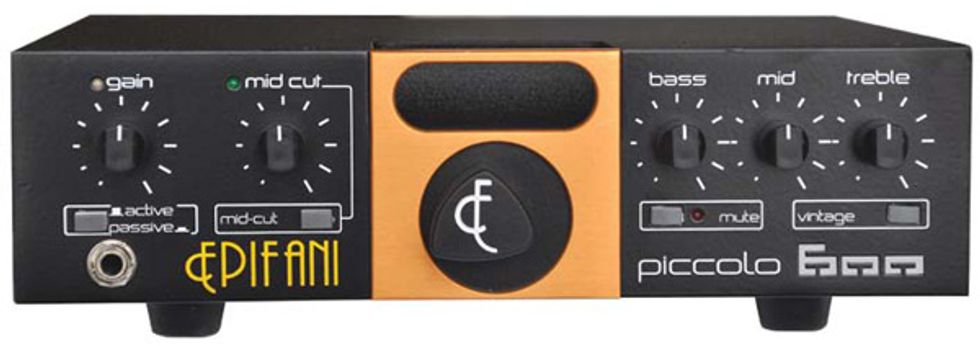
A close-up view of the new Piccolo 600 head, which has Active/Passive, Mid-Cut,
Mute, and Vintage pushbuttons, as well as Gain, Mid-Cut, Bass, Mid, and Treble knobs.
He was the inventor of the 6-string bass. Did you see a future in this instrument, and how did it change your thinking?
At the time, any 2x10 had a hard time keeping up with a low B. With my cabinets, you can slap the low B without it farting out. Again, it goes back to tuning. Other manufacturers weren’t tuning cabs for that. Because of this, a lot of players were trained not to play the low B string so hard. Now you can play with continuity because of the developments we changed early on. If you have ever seen Anthony play, then you know how hard he can play. Right away, I knew I would have to change the suspension, make a bigger voice coil, etc. When you work with players, perfecting according to styles and needs, you learn so much about your craft, while pushing new innovation.
I am constantly talking with working musicians about development and needs. It’s the guys who are the weekend players that I listen to. Honestly, professionals don’t spend much money on gear—it’s the working players who do. For example, at the time, nobody was really making a 1x10 or 1x12 cab. People needed a cabinet to take on the subway and taxis, and that’s where the idea for the UL (Ultra Light) lines was born.
NYC obviously influenced your product development. Could you have done this in another town?
Chicago comes to mind, but I design my cabs and amps around the players. So being in touch with them throughout the years has helped, and New York has a lot of great players in a relatively small space. In visiting all the underground clubs over the years, I would bring a cabinet or two by the club and get input from the best players anywhere, while spreading my name throughout the community of musicians. The biggest stars would frequent the tiny clubs to pick touring musicians, and it would end up being this crazy jam session of historic proportions. It was good to be a part of that.
When did you start feeling less like a boutique company and more mainstream?
When we started selling more gear [laughs]! Seriously, we had the NYC line of cabinets, which was the 115, 215, 112, 110, 210, 310, 410, and 610. Working with Eminence yet again, over the course of two years we developed an efficient neodymium speaker. This put the speaker weight down to 4.6 pounds each, and we used Italian poplar rather than plywood, which cut cabinet weight in half. The UL series was the result, with the UL 410 cab weighing 56 pounds. This was the next big step in our company’s growth. Once the UL was reviewed in a national publication, it took on a new meaning for our company. Our innovations— bracing, 80-ounce magnets, and speaker designs—were being noticed by the big boys, and they started having to redesign and play catch-up. At NAMM, the other builders would visit and talk about my innovations—which was a big compliment. As we have grown through the years, I have noticed more and more backline companies coming to me with requests for gear. That is a huge step forward as the word spreads around the globe.
Speaking of innovation, you have a new development in your D.I.S.T. cabinets.
Yes! The Dual Impedance Speaker Technology is something we are very proud of. Every speaker in the world has a single voice coil. We are the first to develop a dual voice coil, with a user-selectable 8Ω or 4Ω impedance, which allows single or multiple cabinet use. We can put them in series or in parallel. Nobody else has been able to perfect this feature.
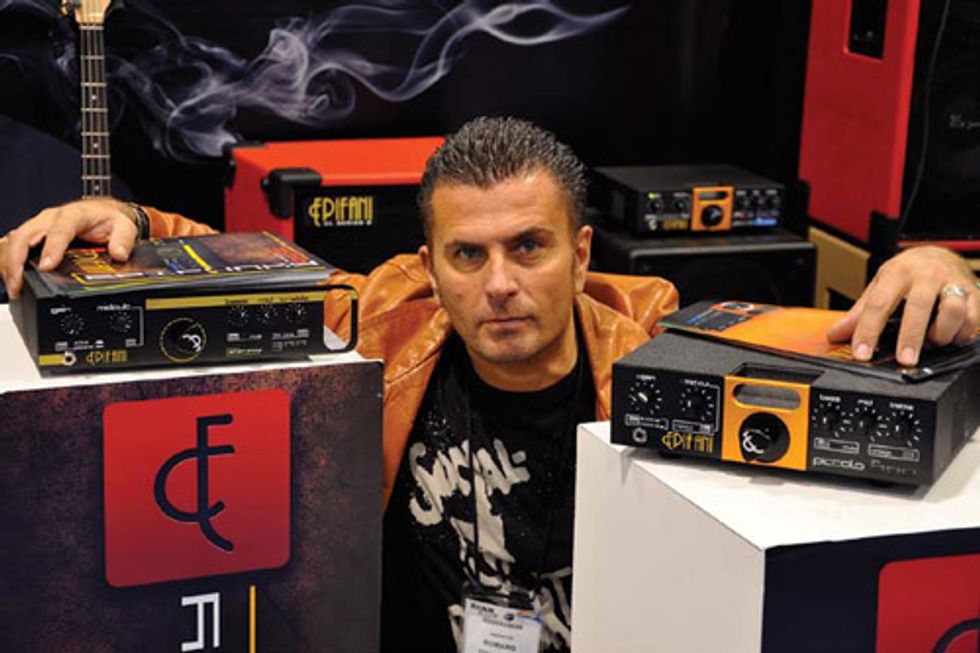
Romano Ferretti, who teamed with Epifani to create a line of rock-focused bass amps,
shows off the new Epifunky 300 (left) and Piccolo 600—both of which weigh just 4.5 pounds.
Let’s talk amps.
I had three tube preamps early on that never made it to production. The cabinets were selling well, and we were quite busy with those. And, honestly, lack of manpower and capital kept amps out of our lines—but not off our radar. This was in 1999. We had a design for a digital amplifier at the time, years before bass amps started shrinking. We could have made very small, powerful amps, but listened to the suits who advised against such a move. We pushed ahead at a later date, and the PS 400 and PS 1000 were born. Our flagship amp, the UL 902C, utilizes an amplifier about the size of two packs of cigarettes to produce 1800 watts. We chose to put it in a 19" rack, but easily could have made it fit in the palm of your hand.
What sets your amps apart from others?
Well, first of all, when we started all other amps used to have some type of sound—the manufacturers decided what sort of sound you would get. You know when you hear this brand or that brand. We decided early on to give the tools back to the player to achieve whatever sound they want without limitation. We let you make your own sound. We constructed the preamps to be as flat as possible, with the opportunity to create any type of sound you have in mind. Also, we have fewer components in our amps. When you run the signal through too many components, the sound is washed out. So we try to keep circuitry down and keep the signal as straight as possible. This allows a cleaner, more powerful tone.
Also, our amp circuitry isn’t dependent on the components. You can use the best components possible, but if the amp doesn’t work, then it doesn’t matter. We wanted it all to work. The UL 502 and 902C are true 2-channel amps. If you plug in one bass, you can use a footswitch to jump between them, or you can plug into each channel and control two instruments—such as an electric and an upright, or a fretted and fretless—with simple, independent EQs.
That design seems inspired by the jazz world. Do you feel you cater more to jazz players?
It is where we started, but the interaction also led to many innovations—because jazz players are more demanding in their sound. Last year, we started catering to the rock world. The new rock line we have planned is going to be a new era in bass. I have noticed a lot of builders with “rock lines,” but they are just repackaged copies of old products. Where is the innovation in that? We have a new designer and rock player named Romano Ferretti, and we’re designing a new look and new features in the Epifani line.
Which leads us to the future of Epifani. What’s next?
The UL 501 is a single-channel version of the 502, but this amp has another innovation built in. We use a class-AB power amplifier, and instead of using bulk transformers, we designed a switching power supply made specifically for audio. It comes in at 7 pounds, with 850 watts of continuous power. It rivals any power amp that claims 1200 or 1500 watts. We have also been working on the new Piccolo amp for the past three years. In the rush to make smaller amps, I didn’t want to get something out just for the sake of being small. It had to sound like I wanted it to sound. It comes in at 4.5 pounds and 600 watts, and it has a big, round, tone. We are very proud of this achievement. We are also reintroducing our combo amps, which will probably be based around the Piccolo.
What are bass players asking for now, as opposed to 20 years ago?
Styles have changed, and it seems we are hearing frequencies in bass that we didn’t hear 20 years ago. It seems that everyone wants the new technology of smaller and lighter cabinets and amps, but they want the same thing—good sound. At the gig, at the end of the night, you want to know that you rattled the back of the room. You want to know that you came with power, clarity, and a big, fat tone.
What would you like to tell bassists who have never played your amps or cabs?
Plug in, listen, and trust your ears!
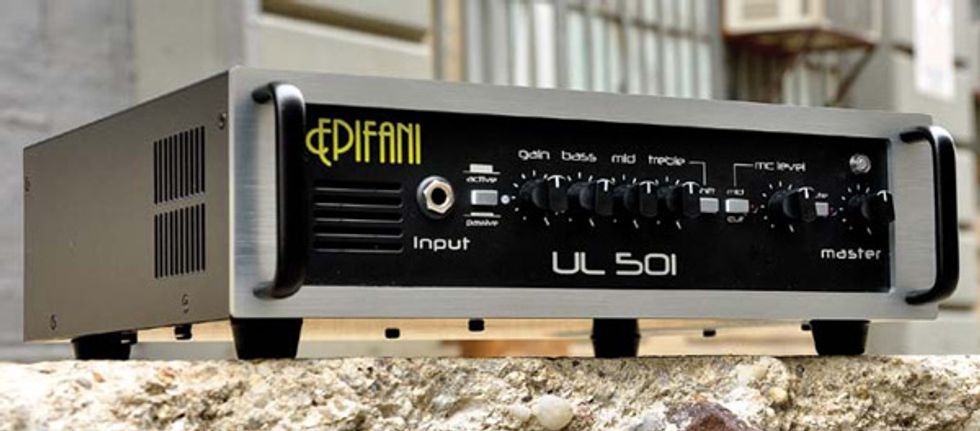
The new, single-channel UL 501 rocks 800 watts at 4Ω (1400 at 2 Ω) and weighs only 8 pounds.





















